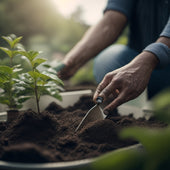
Why High Humidity Stunts Urban Garden Growth
Share
You may think high humidity is a blessing for your urban garden, but it can be a silent killer, stunting growth and causing a range of problems. Waterlogged soil deprives roots of oxygen, making them vulnerable to disease and pests. Excess moisture also disrupts nutrient dynamics, leading to deficiencies and toxicity. In addition, high humidity slows down photosynthesis, reduces crop yields, and attracts pests and insects. As you navigate these challenges, you'll need to explore strategies to improve air circulation, prevent root rot, and manage fungal diseases - and that's just the beginning of revealing the secrets to thriving in humid conditions.
Key Takeaways
• High humidity impairs root growth by limiting oxygen availability, leading to reduced nutrient absorption and increased susceptibility to diseases.
• Excess moisture masks nutrient deficiencies, leaches essential nutrients, and disrupts nutrient uptake, causing stunted growth and yellowing leaves.
• Fungal diseases and pests thrive in high humidity, spreading rapidly and devastating plant health and yields if left unmanaged.
• High humidity reduces photosynthesis efficiency, leading to decreased energy production, stunted leaves, and weak stems.
• Chronic plant stress due to excessive water loss weakens immune systems, making plants more susceptible to diseases and pests.
High Humidity Effects on Roots
As you explore the world of urban gardening, you'll find that high humidity greatly impairs root growth by limiting oxygen availability, leading to reduced absorption of vital nutrients. This is because roots need oxygen to respire and absorb nutrients efficiently. When humidity is high, the air spaces in the soil fill with water, reducing oxygen availability and hindering root function. As a result, root health suffers, and plants become more susceptible to disease and pests.
To mitigate the effects of high humidity on roots, it's crucial to maintain a delicate moisture balance. This can be achieved by ensuring good soil drainage, incorporating organic matter to improve soil structure, and avoiding overwatering.
By doing so, you'll create an environment that supports healthy root growth and development. Remember, ideal root health is critical for plant growth and productivity.
Waterlogged Soil and Oxygen Deprivation
When you're dealing with waterlogged soil in your urban garden, you're fundamentally choking the life out of your plants' roots.
Soil saturation prevents oxygen from reaching the root system, causing it to suffocate and limiting its ability to absorb essential nutrients.
As you'll soon discover, this oxygen deprivation can have devastating consequences for your garden's overall health and productivity.
Soil Saturation Effects
In high-humidity environments, you'll often find that soil saturation effects, characterized by waterlogged soil and oxygen deprivation, can severely impede urban garden growth. When soil is oversaturated, it can't drain excess water, leading to oxygen deprivation and reduced root growth. This can be particularly problematic in urban gardens, where soil drainage is often compromised by compacted soil, poor soil structure, or inadequate drainage systems.
| Soil Type | Moisture Retention | Soil Drainage |
|---|---|---|
| Clay | High | Poor |
| Silt | Medium | Medium |
| Sand | Low | Good |
As the table above illustrates, different soil types have varying levels of moisture retention and soil drainage. In high-humidity environments, it's important to choose soil mixes that prioritize good drainage to prevent waterlogging. You can also take steps to improve soil structure, such as adding organic matter or perlite, to enhance soil drainage and reduce the risk of oxygen deprivation. By understanding the soil saturation effects of high humidity, you can take proactive steps to optimize your urban garden's growing conditions and promote healthy plant growth.
Root System Suffocation
You'll quickly realize that waterlogged soil and oxygen deprivation can lead to root system suffocation, a condition where roots are literally smothered by excess moisture, cutting off their oxygen supply and impeding their ability to function.
This can be devastating for your urban garden, as roots need oxygen to undergo root respiration, a process vital for plant growth and development.
When soil is waterlogged, the pores become filled with water, reducing soil aeration and making it difficult for oxygen to reach the roots. As a result, root growth slows down, and the plant's ability to absorb important nutrients is compromised.
If left unchecked, root system suffocation can lead to root rot, further exacerbating the problem.
To prevent this, it's important to guarantee good soil drainage and aeration. You can achieve this by adding organic matter like compost or perlite to your soil, which will help to improve its structure and increase oxygen availability to the roots.
Fungal Diseases Thrive in Moisture
As you tend to your urban garden, you'll notice that high humidity creates an ideal environment for moisture-loving fungi to spread.
In humid climates, these fungi grow rapidly, increasing the risk of infection in your plants.
Moisture-Loving Fungi Spread
Fungal diseases thrive in humid environments, and high moisture levels create an ideal breeding ground for moisture-loving fungi to spread rapidly in your urban garden. You might notice the onset of fungal diseases when you see white, cottony growth or black spots on your plants. These symptoms can quickly escalate, causing significant damage to your crops.
Moisture-loving fungi exploit high humidity to complete their lifecycle, which typically involves three stages: infection, colonization, and reproduction. Effective moisture regulation is essential to disrupt this cycle. Here's a breakdown of how fungi adapt to humidity levels:
| Humidity Level | Fungal Response | Impact on Urban Garden |
|---|---|---|
| Low (40-50%) | Fungal growth slows | Plants remain relatively healthy |
| Moderate (50-70%) | Fungal growth accelerates | Plants begin to show symptoms |
| High (70-90%) | Fungal growth explodes | Plants are severely damaged or die |
Humid Climates Favor Growth
In humid climates, moisture-rich environments favor the growth of fungal diseases, allowing them to thrive and spread rapidly in your urban garden. As an urban gardener, you're likely familiar with the challenges of managing humidity levels, especially when growing tropical plants that thrive in moisture-retentive conditions. However, this same moisture retention that benefits your plants also creates an ideal breeding ground for fungal diseases.
Here are three ways humid climates facilitate the growth of fungal diseases:
-
Optimal temperature and moisture: Fungal diseases thrive in temperatures between 64°F and 90°F (18°C and 32°C), which is typical of most urban gardens in humid climates. The high moisture levels in these environments allow fungal spores to germinate and spread quickly.
-
Increased humidity: High humidity slows down the rate of water evaporation, creating a perpetually moist environment that fungal diseases love.
-
Poor air circulation: In humid climates, air circulation is often limited, which prevents plants from drying out and makes them more susceptible to fungal infections.
Dampness Breeds Infection
When you're cultivating plants in a humid urban garden, you're inadvertently creating a perfect storm of moisture that fungal diseases exploit to infect your crops. Fungal spores thrive in humid environments, where they can germinate and spread rapidly. As a result, your plants become more susceptible to diseases like powdery mildew, leaf spot, and root rot.
To prevent fungal diseases from taking hold, it's crucial to implement effective moisture management strategies. Start by ensuring good air circulation around your plants, which can help to reduce humidity and prevent moisture from accumulating on leaves.
You should also avoid overwatering, as this can create an ideal environment for fungal growth. Implementing a drip irrigation system can help to deliver water directly to the roots, reducing evaporation and runoff.
Additionally, consider incorporating disease-resistant varieties into your garden, and practice good sanitation by removing infected plants or debris promptly.
Nutrient Deficiency and Toxicity
High humidity can mask underlying nutrient deficiencies in your urban garden, allowing plants to appear healthy even as they're starving for essential micronutrients. This can lead to a nutrient imbalance, where plants receive too much of one nutrient and not enough of another. As a result, you might notice stunted growth, yellowing leaves, or other signs of nutrient deficiency.
Here are three ways high humidity can contribute to nutrient deficiency and toxicity:
-
Reduced nutrient uptake: High humidity can reduce the rate at which plants absorb nutrients from the soil, leading to deficiencies over time.
-
Increased fungal activity: Fungi thrive in humid environments and can outcompete plants for essential nutrients, exacerbating deficiencies.
-
Toxic buildup: Excess moisture can lead to the buildup of toxic compounds in the soil, which can be absorbed by plants and cause damage or even death.
Slowed Photosynthesis and Growth
Humidity's stifling grip on your urban garden slows photosynthesis, crippling your plants' ability to produce energy and ultimately hindering their growth. As a result, your plants struggle to convert light into energy, a process that's essential for growth and development.
When humidity is high, the air is saturated with water vapor, making it difficult for plants to release excess moisture through transpiration. This leads to increased leaf temperature, which reduces light intensity and further slows photosynthesis.
As photosynthesis slows, your plants' energy production decreases, impacting their ability to grow and thrive. You may notice stunted leaves, weak stems, and reduced yields. Additionally, high humidity can lead to leaf waterlogging, causing roots to rot and further exacerbating growth issues.
To combat this, consider using techniques like pruning, mulching, and improving air circulation to reduce humidity and promote healthy growth. By understanding the impact of high humidity on photosynthesis, you can take targeted steps to create a more conducive environment for your urban garden to flourish.
Pests and Insects Attracted to Moisture
As you endeavor to optimize your urban garden's growth, you'll also need to contend with the unwanted visitors that thrive in moist environments. Pests and insects are naturally drawn to the excess moisture that high humidity provides. This can lead to an explosion in the pest population, which can wreak havoc on your garden.
Here are three key reasons why high humidity attracts pests and insects:
-
Moisture-rich environments: Pests and insects thrive in humid environments, as the excess moisture allows them to survive and multiply.
-
Altered insect behavior: High humidity can alter insect behavior, making them more aggressive and likely to infest your garden.
-
Ideal breeding conditions: Moist environments provide ideal breeding conditions for pests and insects, allowing them to reproduce rapidly and spread quickly.
Physical Damage to Plant Structures
Moisture-laden air can compromise the physical integrity of your plants, causing leaves to become waterlogged and stems to weaken. This can lead to a range of humidity damage effects that can stunt your urban garden's growth. As a gardener, it is crucial to understand how high humidity can impact plant structure integrity.
| Humidity Damage Effects | Plant Structure Integrity Impact |
| Leaf Waterlogging | Reduced photosynthesis, increased risk of fungal diseases |
| Stem Weakening | Increased risk of stem breakage, reduced plant stability |
| Root Rot | Reduced nutrient uptake, increased risk of plant death |
When leaves become waterlogged, they can no longer perform photosynthesis efficiently, making it difficult for your plants to thrive. Weakened stems are more susceptible to breakage, which can further compromise plant structure integrity. Additionally, excess moisture can cause root rot, reducing your plants' ability to absorb essential nutrients. By understanding these humidity damage effects, you can take proactive measures to mitigate their impact and guarantee your urban garden remains healthy and thriving.
Increased Transpiration and Stress
When your plants are exposed to high humidity, they respond by increasing transpiration rates, which can lead to stress and further exacerbate the negative impacts on your urban garden's growth.
This is because high humidity reduces the rate of water loss through transpiration, causing your plants to overcompensate and lose more water than necessary. As a result, your plants become stressed, which can weaken their immune systems and make them more susceptible to disease.
Here are three ways high humidity affects your plants' transpiration rate and resilience:
-
Increased water loss: High humidity triggers your plants to increase their transpiration rate, leading to excessive water loss and stress.
-
Reduced plant resilience: Chronic stress from high humidity can weaken your plants' natural defenses, making them more vulnerable to pests and diseases.
-
Impaired photosynthesis: Stressed plants often experience reduced photosynthesis rates, which can further impede their growth and development.
Limited Crop Selection and Yield
In high-humidity urban gardens, you may find that certain crops thrive, but many others struggle to survive, let alone produce a decent yield. This limited crop selection is a significant constraint on urban gardeners, as they're forced to choose between crops that can tolerate high humidity and those that can't. As a result, crop diversity suffers, and you're left with a limited range of options.
To make matters worse, high humidity also hinders yield optimization. When plants are stressed due to excess moisture, they divert energy from fruiting and flowering to survival, leading to reduced yields. This means you'll get fewer fruits, vegetables, or flowers from each plant, further reducing the overall productivity of your garden.
To overcome these challenges, you'll need to carefully select crops that are tolerant of high humidity and implement strategies to improve air circulation, reduce moisture, and optimize growing conditions. By doing so, you can promote healthy plant growth, increase crop diversity, and achieve better yields in your urban garden, even in humid environments.
Frequently Asked Questions
Can I Use Mulch to Reduce Humidity in My Urban Garden?
You can use organic mulch like straw or bark chips to reduce humidity, but be cautious of moisture retention; inorganic mulch like gravel or stone may be a better option to minimize humidity in your urban garden.
Are There Any Humidity-Tolerant Plants for Urban Gardens?
Imagine your urban oasis thriving despite the humid haze! You can cultivate humidity-tolerant herbs like basil and mint, and tropical vegetable varieties like okra and eggplant, which will flourish in the steamy atmosphere.
How Often Should I Water My Plants in Humid Weather?
When creating a watering schedule for humid weather, you'll want to monitor soil moisture retention closely, watering only when the top 2-3 inches of soil feel dry to the touch, to avoid overwatering.
Can I Use Fans to Improve Air Circulation in My Garden?
"You're surrounded by a steamy jungle, but you can blast away the stagnation! Strategically place fans to create whirlwinds of air circulation, angling them to hit leafy hotspots, and watch your garden transform into a thriving oasis."
Are There Any Organic Fungicides to Combat Humidity-Related Diseases?
You'll find effective organic fungicides in neem oil, copper-based products, and bicarbonate-based solutions, which offer varying levels of fungicide efficacy against humidity-related diseases; research each organic alternative's application and efficacy to select the best fit for your garden.
Related Posts
-

3 Best Tool Essentials for Creative Concrete Planters
To create visually stunning and durable concrete planters, you'll need three essential tool categories. First, you'll...
-

3 Best Tool Essentials for Creative Concrete Planters
To create visually stunning and durable concrete planters, you'll need three essential tool categories. First, you'll...
-

3 Best Tool Essentials for Creative Concrete Planters
To create visually stunning and durable concrete planters, you'll need three essential tool categories. First, you'll...
-

3 Best Tool Essentials for Creative Concrete Planters
To create visually stunning and durable concrete planters, you'll need three essential tool categories. First, you'll...
-

3 Best Tool Essentials for Creative Concrete Planters
To create visually stunning and durable concrete planters, you'll need three essential tool categories. First, you'll...
-

3 Best Tool Essentials for Creative Concrete Planters
To create visually stunning and durable concrete planters, you'll need three essential tool categories. First, you'll...
-

3 Best Tool Essentials for Creative Concrete Planters
To create visually stunning and durable concrete planters, you'll need three essential tool categories. First, you'll...
-

3 Best Tool Essentials for Creative Concrete Planters
To create visually stunning and durable concrete planters, you'll need three essential tool categories. First, you'll...
-

3 Best Tool Essentials for Creative Concrete Planters
To create visually stunning and durable concrete planters, you'll need three essential tool categories. First, you'll...
-

3 Best Tool Essentials for Creative Concrete Planters
To create visually stunning and durable concrete planters, you'll need three essential tool categories. First, you'll...
-

3 Best Tool Essentials for Creative Concrete Planters
To create visually stunning and durable concrete planters, you'll need three essential tool categories. First, you'll...
-

3 Best Tool Essentials for Creative Concrete Planters
To create visually stunning and durable concrete planters, you'll need three essential tool categories. First, you'll...
-

3 Best Tool Essentials for Creative Concrete Planters
To create visually stunning and durable concrete planters, you'll need three essential tool categories. First, you'll...
-

3 Best Tool Essentials for Creative Concrete Planters
To create visually stunning and durable concrete planters, you'll need three essential tool categories. First, you'll...
-

5 Best Trowels for Planting in Concrete Planters
When planting in concrete planters, you need a trowel that can handle the harsh conditions and reduce fatigue on your...
-

5 Best Trowels for Planting in Concrete Planters
When planting in concrete planters, you need a trowel that can handle the harsh conditions and reduce fatigue on your...
-

5 Best Trowels for Planting in Concrete Planters
When planting in concrete planters, you need a trowel that can handle the harsh conditions and reduce fatigue on your...
-

5 Best Trowels for Planting in Concrete Planters
When planting in concrete planters, you need a trowel that can handle the harsh conditions and reduce fatigue on your...
-

5 Best Trowels for Planting in Concrete Planters
When planting in concrete planters, you need a trowel that can handle the harsh conditions and reduce fatigue on your...
-

5 Best Trowels for Planting in Concrete Planters
When planting in concrete planters, you need a trowel that can handle the harsh conditions and reduce fatigue on your...
-

5 Best Trowels for Planting in Concrete Planters
When planting in concrete planters, you need a trowel that can handle the harsh conditions and reduce fatigue on your...
-

5 Best Trowels for Planting in Concrete Planters
When planting in concrete planters, you need a trowel that can handle the harsh conditions and reduce fatigue on your...
-

5 Best Trowels for Planting in Concrete Planters
When planting in concrete planters, you need a trowel that can handle the harsh conditions and reduce fatigue on your...
-

5 Best Trowels for Planting in Concrete Planters
When planting in concrete planters, you need a trowel that can handle the harsh conditions and reduce fatigue on your...
-

5 Best Trowels for Planting in Concrete Planters
When planting in concrete planters, you need a trowel that can handle the harsh conditions and reduce fatigue on your...
-

5 Best Trowels for Planting in Concrete Planters
When planting in concrete planters, you need a trowel that can handle the harsh conditions and reduce fatigue on your...
-

5 Best Trowels for Planting in Concrete Planters
When planting in concrete planters, you need a trowel that can handle the harsh conditions and reduce fatigue on your...
-

5 Best Trowels for Planting in Concrete Planters
When planting in concrete planters, you need a trowel that can handle the harsh conditions and reduce fatigue on your...
-

5 Best Trowels for Planting in Concrete Planters
When planting in concrete planters, you need a trowel that can handle the harsh conditions and reduce fatigue on your...
-

5 Best Trowels for Planting in Concrete Planters
When planting in concrete planters, you need a trowel that can handle the harsh conditions and reduce fatigue on your...
-

5 Best Trowels for Planting in Concrete Planters
When planting in concrete planters, you need a trowel that can handle the harsh conditions and reduce fatigue on your...
-

5 Best Trowels for Planting in Concrete Planters
When planting in concrete planters, you need a trowel that can handle the harsh conditions and reduce fatigue on your...
-

What to Know Before Upcycling Concrete Planters
When upcycling concrete planters, you'll want to start by evaluating the planter's size, shape, and condition to guar...
-

What to Know Before Upcycling Concrete Planters
When upcycling concrete planters, you'll want to start by evaluating the planter's size, shape, and condition to guar...
-

What to Know Before Upcycling Concrete Planters
When upcycling concrete planters, you'll want to start by evaluating the planter's size, shape, and condition to guar...
-

What to Know Before Upcycling Concrete Planters
When upcycling concrete planters, you'll want to start by evaluating the planter's size, shape, and condition to guar...
-

What to Know Before Upcycling Concrete Planters
When upcycling concrete planters, you'll want to start by evaluating the planter's size, shape, and condition to guar...
-

What to Know Before Upcycling Concrete Planters
When upcycling concrete planters, you'll want to start by evaluating the planter's size, shape, and condition to guar...
-

What to Know Before Upcycling Concrete Planters
When upcycling concrete planters, you'll want to start by evaluating the planter's size, shape, and condition to guar...
-

What to Know Before Upcycling Concrete Planters
When upcycling concrete planters, you'll want to start by evaluating the planter's size, shape, and condition to guar...
-

What to Know Before Upcycling Concrete Planters
When upcycling concrete planters, you'll want to start by evaluating the planter's size, shape, and condition to guar...
-

What to Know Before Upcycling Concrete Planters
When upcycling concrete planters, you'll want to start by evaluating the planter's size, shape, and condition to guar...
-

What to Know Before Upcycling Concrete Planters
When upcycling concrete planters, you'll want to start by evaluating the planter's size, shape, and condition to guar...
-

What to Know Before Upcycling Concrete Planters
When upcycling concrete planters, you'll want to start by evaluating the planter's size, shape, and condition to guar...
-

What to Know Before Upcycling Concrete Planters
When upcycling concrete planters, you'll want to start by evaluating the planter's size, shape, and condition to guar...
-

What to Know Before Upcycling Concrete Planters
When upcycling concrete planters, you'll want to start by evaluating the planter's size, shape, and condition to guar...
-

What to Know Before Upcycling Concrete Planters
When upcycling concrete planters, you'll want to start by evaluating the planter's size, shape, and condition to guar...
-

What to Know Before Upcycling Concrete Planters
When upcycling concrete planters, you'll want to start by evaluating the planter's size, shape, and condition to guar...
-

What to Know Before Upcycling Concrete Planters
When upcycling concrete planters, you'll want to start by evaluating the planter's size, shape, and condition to guar...
-

What to Know Before Upcycling Concrete Planters
When upcycling concrete planters, you'll want to start by evaluating the planter's size, shape, and condition to guar...
-

What to Know Before Upcycling Concrete Planters
When upcycling concrete planters, you'll want to start by evaluating the planter's size, shape, and condition to guar...
-

What to Know Before Upcycling Concrete Planters
When upcycling concrete planters, you'll want to start by evaluating the planter's size, shape, and condition to guar...
-

What to Know Before Upcycling Concrete Planters
When upcycling concrete planters, you'll want to start by evaluating the planter's size, shape, and condition to guar...
-

What to Know Before Upcycling Concrete Planters
When upcycling concrete planters, you'll want to start by evaluating the planter's size, shape, and condition to guar...
-

What to Know Before Upcycling Concrete Planters
When upcycling concrete planters, you'll want to start by evaluating the planter's size, shape, and condition to guar...


